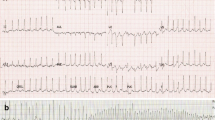Abstract
Adenosine is used increasingly as an alternative to dynamic exercise during myocardial perfusion imaging because it is a powerful coronary vasodilator with a short half-life. Minor side-effects are common but life-threatening events are rare. We report two cases of provocation by adenosine infusion of profound sinus bradycardia progressing to atrial and ventricular asystole. Despite discontinuation of the infusion, asystole persisted for up to 1 min in one case and was accompanied by a grand mal seizure. Normal sinus rhythm returned spontaneously in both cases without long-term sequelae. Sino-atrial disease was later suggested in both cases by 24-h electrocardiographic monitoring. We conclude that patients to whom adenosine is given may have occult sino-atrial disease and may be susceptible to life-threatening arrhythmias. Significant sinus bradycardia during the infusion may provide a warning of its presence.
Similar content being viewed by others
References
Abreu A, Mahmarian JJ, Nishimura S, Boyce TM, Verani MS. Tolerance and safety of pharmocologic coronary vasodilation with adenosine in association with thallium-201 scintigraphy in patients with suspected coronary artery disease. J Am Coll Cardiol 1991;18:730–735
Verani MS, Mahmarian JJ, Hixson JB, Boyce TM, Staudacher RA. Diagnosis of coronary artery disease by controlled coronary vasodilation with adenosine and thallium-201 scintigraphy in patients unable to exercise. Circulation 1990;82:80–87
Nguyen T, Heo J, Ogilby D, Iskandrian AS. Single photon emission computed tomography with thallium-201 during adenosine induced coronary hyperaemia: correlation with coronary arteriography, exercise thallium imaging and two-dimensional echocardiography. J Am Coll Cardiol 1990;16:1375–1383
Coyne EP, Belvedere DA, Van de Streeke PR, Weiland FL, Evans RB, Spaccavento LJ. Thallium-201 scintigraphy after intravenous infusion of adenosine compared with exercise thallium testing in the diagnosis of coronary artery disease. J Am Coll Cardiol 1991;17:1289–1294
Nishimura S, Mahmarian JJ, Boyce TM, Verani MS. Quantitative thallium-201 single photon emission computed tomography during maximal pharmacologic coronary vasodilation with adenosine for assessing coronary artery disease. J Am Coll Cardiol 1991;18:736–745
Cushley MJ, Tattersfield AE, Holgate ST. Inhaled adenosine and guanosine on airway resistance in normal and asthmatic subjects. Br J Clin Pharmacol 1983;15:161–165
Taviot B, Pavheco Y, Coppere B, Pirollet B, Rebaudet P, Perrin-Fayolle M. Bronchospasm induced in an asthmatic by the injection of adenosine. Presse Med 1986;15:1103
Watt AH, Bernard MS, Webster J, Passani SL, Stephens MR, Routledge PA. Intravenous adenosine in the treatment of supraventricular tachycardia — a dose ranging study and interaction with dipyridamole. Br J Clin Pharmacol 1986;21:277–230
Belardinelli L, Linden J, Berne RM. The cardiac effects of adenosine. Prog Cardiovasc Dis 1989;32:73–97
Wilson RF, Wyche K, Christensen BV, Zimmer S, Laxson DD. Effects of adenosine on human coronary arterial circulation. Circulation 1990;82:1595–1606
Bubinski R, Markiewicz K, Cholewa M, Gorski L, Gawor Z, Kus W. Electrophysiologic effects of intravenous dipyridamole. Int J Cardiol 1989;24:327–335
Belardinelli L, Isenberg G. Isolated atrial myocytes: adenosine and acetylcholine increase potassium conductance. Am J Physiol 1983;244: H734-H737
Szegi J, Szentmiklosi AJ, Cseppento A. On the action of specific drugs influencing the adenosine induced activation of cardiac purinoceptors. In: Papp J Gy, ed. Cardiovascular Pharmacology 1987: results, concepts and perspectives. Budapest: Akademiai Kiado; 1987: 591–599
Blumenthal MS, McCauley CS. Cardiac arrest during dipyridamole imaging. Chest 1988;93: 1103–1104
Benedini G, Cuccia C, Bolognesi R, Affatato A, Gallo G, Renaldi E, Visioli O. Value of purinic compounds in assessing sinus node dysfunction in man: a new diagnostic method. Eur Heart J 1984;5: 394–403
Wayne EJ, Goodwin JF, Stoner HB. The effect of adenosine triphosphate on the electrocardiogram of man and animals. Br Heart J 1949;11: 55–67
Watt AH. Sick sinus syndrome: An adenosine mediated disease. Lancet 1985;1: 786–788
Author information
Authors and Affiliations
Rights and permissions
About this article
Cite this article
Pennell, D.J., Mahmood, S., Ell, P.J. et al. Bradycardia progressing to cardiac arrest during adenosine thallium myocardial perfusion imaging in occult sino-atrial disease. Eur J Nucl Med 21, 170–172 (1994). https://doi.org/10.1007/BF00175766
Received:
Revised:
Issue Date:
DOI: https://doi.org/10.1007/BF00175766




